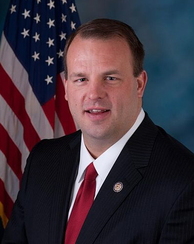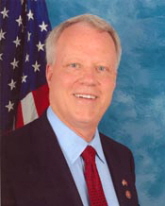The Vanishing Center: Exiting US Representatives
More than half of the U.S. Representatives retiring in 2014 are within 10 points of the ideological center of the chamber according to National Journal’s new vote ratings, compared to just one of 14 members running for higher office

One common narrative accounting for these exits is that many centrists are departing the chamber: with the U.S. House becoming more polarized in recent years, increased partisan gridlock has rendered the centrists increasingly ineffectual (and no doubt increasingly frustrated).
National Journal’s recently released 2013 vote ratings yields data to back this narrative – with an added wrinkle.
While many of those retiring from the U.S. House are among the most centrist in the chamber, those exiting to run for higher office are among the most ideological.
To date, 17 U.S. Representatives have announced their retirement at the end of the term (those not seeking higher office) – 10 Republicans and seven Democrats.
Fifteen of these lawmakers were scored by National Journal for the 2013 votes (two missed more than half of the key votes for the publication’s scored legislation: California Republican John Campbell and New York Democrat Carolyn McCarthy).
More than half of these 15 U.S. House members are within 10 percentage points of the ideological center of the chamber – five Republicans and three Democrats.
New Jersey GOPer Jon Runyan is the closest to the center among these eight representatives at just 2.5 points from the 50th percentile, compiling a composite liberal score of 47.5 and composite conservative score of 52.5.
(The respective scores mean Runyan’s key votes in 2013 were more liberal than 47.5 percent of the chamber and more conservative than 52.5 percent).
Runyan’s announcement last November turned heads as he was the first Garden State sophomore U.S. Representative not to run for a third term or seek higher office in 65 years – ending a string of 56 representatives in a row since 1948.
Seven-term Utah Democrat Jim Matheson is the next most centrist 2014 retiree based on last year’s voting record – coming in at 2.7 points off the 50th percentile mark (52.7 liberal, 47.3 conservative).
The other six centrist 2014 retirees are:
· North Carolina Democrat Mike McIntyre (NC-07): 4.2 points off the ideological center (52.2 LIB, 45.8 CON)
· New York Democrat Bill Owens (NY-21): 5.3 points (55.3 LIB, 44.7 CON)
· Iowa Republican Tom Latham (IA-03): 7.8 points (42.2 LIB, 57.8 CON)
· California Republican Buck McKeon (CA-25): 9.3 points (40.7 LIB, 59.3 CON)
· Alabama Republican Spencer Bachus (AL-02): 9.5 points (40.5 LIB, 59.5 CON)
· Virginia Republican Frank Wolf (VA-10): 9.8 points (40.2 LIB, 59.8 CON)
One other U.S. Representative – Pennsylvania Republican Jim Gerlach – nearly made the list at just 11 points from the ideological center of the chamber.
The remaining six retirees were considerably more ideological: Democrats George Miller of California (34.0 points), Jim Moran of Virginia (33.2 points), and Henry Waxman of California (32.7 points) and Republicans Michele Bachmann of Minnesota (32.8 points), Tim Griffin of Arkansas (24.7 points), and Howard Coble of North Carolina (22.8 points).
As for the two retirees who did not have enough votes for National Journal to score in 2014, John Campbell was only three points off the ideological center in 2012 (47.0 LIB, 53.0 CON) while Carolyn McCarthy was more ideological at 16.5 points (66.5 LIB, 33.5 CON).
Distance from Ideological Center Among 2014 U.S. House Retirees
|
District
|
US Representative
|
Party
|
Points*
|
|
NJ-03
|
Jon Runyan
|
Republican
|
2.5
|
|
UT-04
|
Jim Matheson
|
Democrat
|
2.7
|
|
NC-07
|
Mike McIntyre
|
Democrat
|
4.2
|
|
NY-21
|
Bill Owens
|
Democrat
|
5.3
|
|
IA-03
|
Tom Latham
|
Republican
|
7.8
|
|
CA-25
|
Buck McKeon
|
Republican
|
9.3
|
|
AL-02
|
Spencer Bachus
|
Republican
|
9.5
|
|
VA-10
|
Frank Wolf
|
Republican
|
9.8
|
|
PA-06
|
Jim Gerlach
|
Republican
|
11.0
|
|
NC-06
|
Howard Coble
|
Republican
|
22.8
|
|
AR-02
|
Tim Griffin
|
Republican
|
24.7
|
|
CA-33
|
Henry Waxman
|
Democrat
|
32.7
|
|
MN-06
|
Michele Bachmann
|
Republican
|
32.8
|
|
VA-08
|
Jim Moran
|
Democrat
|
33.2
|
|
CA-11
|
George Miller
|
Democrat
|
34.0
|
* Denotes percentage points from the 50th percentile, or the ideological center of the House of Representatives. Table compiled by Smart Politics with 2013 National Journal Vote Ratings data.
For those who envision the U.S. Senate restoring its once-held reputation as the less partisan and more cooperative legislative chamber, consider this:
Of the 14 U.S. Representatives exiting the chamber in hopes of winning higher elected office (12 running for the U.S. Senate and two running for governor), only one scored within 10 points of the ideological center.

The other two – Jack Kingston and Phil Gingrey – are 40.0 points and 38.7 points respectively away from the ideological center of the House on the 100-point scale.
Overall, the 14 U.S. Representatives seeking higher office scored an average of 23.5 points from the ideological center while the 15 scored retirees came in at 16.2 points from the center.
Distance from Ideological Center Among 2014 U.S. Representatives Running for Higher Office
|
District
|
US Representatives
|
Party
|
Points*
|
|
GA-10
|
Paul Broun
|
Republican
|
9.2
|
|
MI-14
|
Gary Peters
|
Democrat
|
11.0
|
|
WV-02
|
Shelley Moore Capito
|
Republican
|
13.2
|
|
ME-02
|
Mike Michaud
|
Democrat
|
18.7
|
|
PA-13
|
Allyson Schwartz
|
Democrat
|
19.0
|
|
AR-04
|
Tom Cotton
|
Republican
|
20.7
|
|
TX-36
|
Steve Stockman
|
Republican
|
20.7
|
|
HI-01
|
Colleen Hanabusa
|
Democrat
|
23.0
|
|
MT-AL
|
Steve Daines
|
Republican
|
24.7
|
|
IA-01
|
Bruce Braley
|
Democrat
|
26.2
|
|
OK-05
|
James Lankford
|
Republican
|
30.0
|
|
LA-06
|
Bill Cassidy
|
Republican
|
34.2
|
|
GA-11
|
Phil Gingrey
|
Republican
|
38.7
|
|
GA-01
|
Jack Kingston
|
Republican
|
40.0
|
* Denotes percentage points from the 50th percentile, or the ideological center of the House of Representatives. Table compiled by Smart Politics with 2013 National Journal Vote Ratings data.
Note: It should be added that no matter how polarized a particular Congress may be, there will always be a numerical ‘center.’ That is to say, those names appearing in the middle of the National Journal rankings from each party may be much more ideological in their voting behavior than legislators similarly in the middle from, say, two or three decades ago, but are nonetheless called centrist lawmakers today.
Follow Smart Politics on Twitter.
